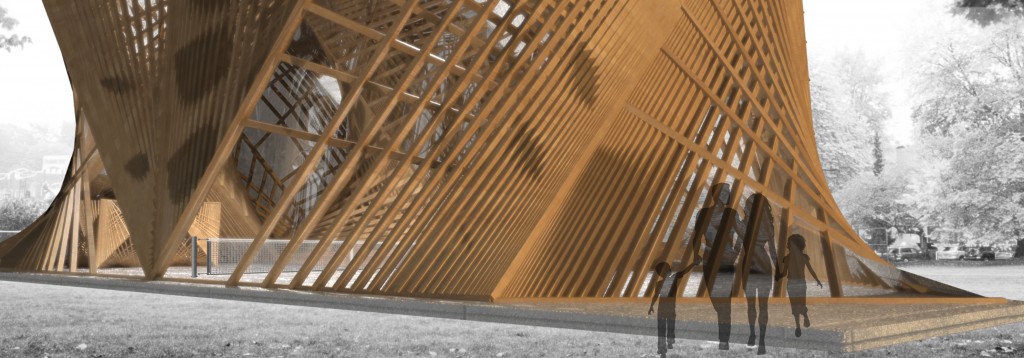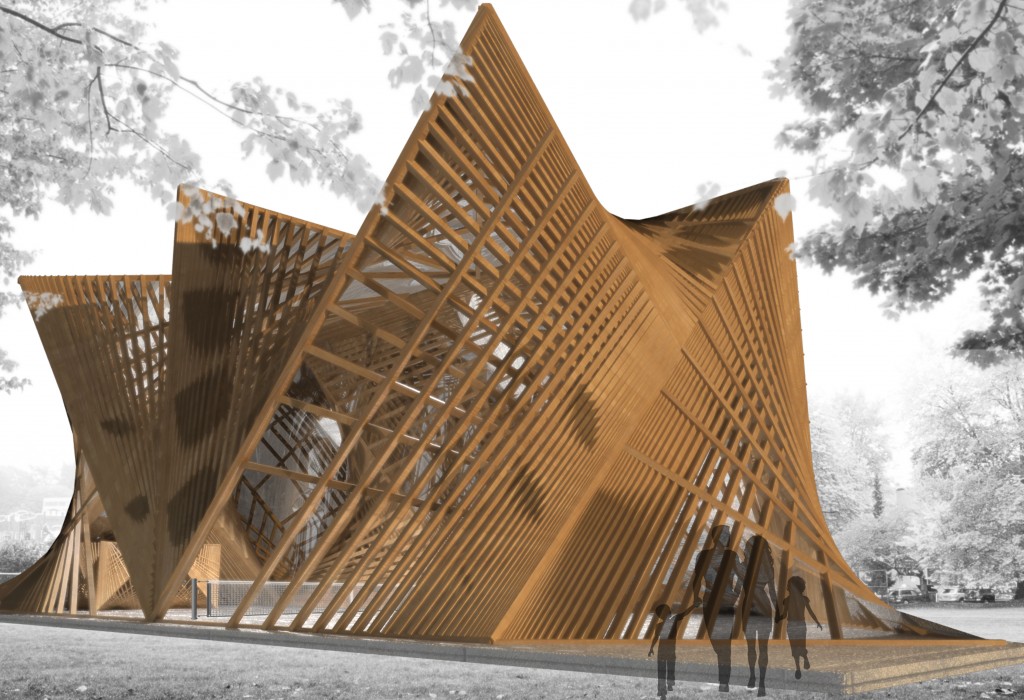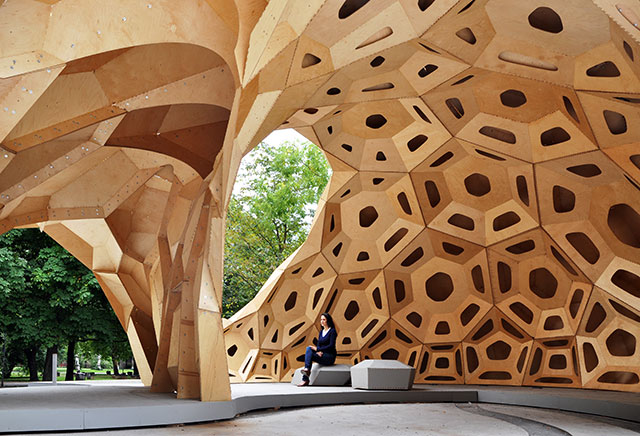Experiments in shell structures and membranes in timber
Surface structures have fascinated architects since the Renaissance with domes, and vaults providing the first examples and more recently with more complex forms such as Gaudi’s Sagrada Familia, Saarinen’s TWA Terminal, and Toyo Ito’s Funeral Hall. One can speculate on what draws us to these forms – perhaps their lightness, their curved forms, their complex interaction with light or the intuitive flow of force which is expressed within their form. The hyper-efficiency of the structures provide an architectural form which seems to defy gravity.
When we consider surface structures in architecture wood has not played a large role in these types of structures to date however current digital manufacturing techniques and highly advanced analysis capabilities may be able to change this. Wood is easy to machine and can be additive or subtractive in its manufacturing and construction processes. Wood is valued in architecture for its colour, texture, smell, tactile and light reflecting properties. It is also highly sustainable and can function as structure, ornament, finish or enclosure.
This studio will challenge the conception of wood as it is currently understood. It will take on conventional notions of wood in order to expand its use and investigate value added processes in timber in order to advance the state of the art and propose new uses and applications of wood in architecture. We will ask wood to perform as a surface structure, speculating on how to do this. We will research current state of the art experiments and processes in wood design today and speculate on the manufacturing processes and structural behaviour required to propose new forms and modes of surface structures fabricated from wood.
Structure
Although seeming to deny gravity, in fact surface structures are derived from gravity itself and Gaudi, Frei Otto and Heinz Isler provide us compelling examples of form finding and the predictable funicular forms which result from these experiments. However, when an architect chooses to deviate from these funicular forms, the structure requires material in the areas where the deviation from structural force flow ideals occur in order to carry some bending in the structure at this point. Modulation in the shell structure is required at these points, requiring an increase of structural capacity either by increasing the strength or depth of the shell at this point. To date, projects like Toyo Ito and Matsuro Sasaki’s Funeral Hall in Kakamigahara optimize shell structures to ensure the forces are within ranges of acceptable limits for a consistent shell depth however modifying the shell to respond to the forces is another method of approaching this. Ideas such as modifying the material allocation by advanced fabrication methods allows the structure to respond to the loads applied.
Other approaches to surface structures can be demonstrated by a folded plate or rippled structure, whose depth provide its resistance to gravity. These surface structures use their global geometry to give strength, maintaining lightness while the depth works for them structurally.
Material
Material in architecture is part of the repertoire for invention. The architect defines space and experience with material and the understanding of the material media is critical to the finesse of the built form. The ability to invent with any material is based on the understanding of and experimentation with that media. Historically in architecture, developments in the technologies of materials serve as catalysts for new languages of architecture. The palette with which the architect designs is material based and the material’s qualities of texture, colour, light reflectance, density of arrangement, permeability and feel to the touch can simultaneously provide a space with mood, order, envelope, and structure. This studio experiments with the material wood, looking to expand its role in architecture from a hierarchical monodirectional material to a flowing multidirectionally spanning surface.
Culture
Timber on the West Coast has played a large role in the development of its architectural language – the West Coast Modern architecture uses predominantly timber post and beam to create its relationship between interior and exterior and its connection to the landscape. Moving into our contemporary culture, we move to a more fragmented and heterogeneous architecture heavily influenced by digital tools. What innovations can we bring to timber and how might this affect the language of architecture in our region?
Technology
The potentials of digital modeling, simulation and fabrication provide the architect with a bionic ability to gain understanding and manipulate materials. The alternate space of the digital used simultaneously with the tangible world provides another realm in which to experiment both limited and unlimited by material. The ability to speculate on the material uses and the understanding of the material itself is enhanced by the digital and this realm then brought back to the physical, even iterating and learning and experimenting from the iterations. As such, representation in this studio will be expanding our experience with the parametric, using Grasshopper in Rhino as well as any other plug-ins which become relevant to the project.
Project
This studio will begin with a research component looking into shell and surface structures, timber and timber fabrication and digital design tools. Research will be group work. The projects in this studio will be a development of a timber surface which functions as structure and envelope envelope and then application of this invented surface to a program brief. Projects will be individual work and will involve physical and digital models of the surface composition as well as the final project.
Images above from projects by Achim Menges, Patricia Patkau and the Author




